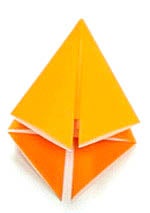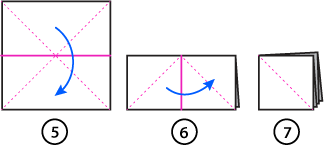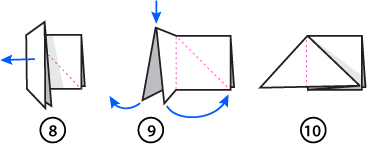Paper Protein Activity - Part 1 - Amino Acids
By Marcella Martos

We have a fun paper folding activity. Remember how proteins are made of building blocks called amino acids, and have their own special shape? Not only do proteins look different, they have different jobs to do inside the cell to keep your body running smoothly.
The protein we made is a channel that sits in the outer cell surface, or membrane, and works like a door that lets certain molecules pass through. Some channels are open all the time while others can be closed depending on signals from the cell or the environment. When the channel is open, other molecules can enter the cell by passing through the hole in the middle.
As you'll discover while building your origami channel, the shape of a protein is very important. If you don't fold your origami amino acids correctly, they wouldn’t fit together to make a protein chain. Or, if you make a mistake joining amino acids together, the finished channel might not be able to open and close correctly.
In nature the same thing can happen. If a protein is the wrong shape it will not work correctly.
Materials: You will need 8 square pieces of paper of the same size.
Tips: The best way to make folds is to lay the paper down on a hard, flat surface, such as a table. It's important to pay attention to the direction of the paper and make sure not to change it's orientation when following instructions.

You can find out more about how proteins fold into unique shapes to make and do work inside your body in the Protein Science section.
You can also download and print our Origami Protein Handout (PDF) for step-by-step instructions of how to make your protein channel, or watch this step by step video.
Let's Begin!

1. Fold a single piece of paper in half diagonally
2. Fold the paper in half diagonally again
3. Your folded paper should look like this
4. Unfold the paper

5. Fold the paper in half
6. Fold the paper in half again
7. Your folded paper should look like this

8. Unfold the top layer of the square halfway
9. Open the top layer of the square and flatten it into a triangle, using the existing creases.
10. Your folded paper should look like this
11. Flip it over
12. Unfold the top layer halfway
13. Open the top layer and flatten it into a triangle, using the existing creases.
14. Your folded paper should look like this
15. Fold the edges of the top layer only into the centerline
16. Your folded paper should look like this
17. Flip it over
18. Fold the edges of the top layer only into the centerline
19. You've now completed one amino acid. Repeat these steps with another piece of paper until you've created a total of eight amino acids.

And, that's it! Once you have amino acids, you are ready to move onto Part 2 to make the protein channel.
Read more about: Venom!
Bibliographic details:
- Article: Paper Protein Origami Activity - Part 1
- Author(s): Dr. Biology
- Publisher: Arizona State University School of Life Sciences Ask A Biologist
- Site name: ASU - Ask A Biologist
- Date published: 16 Aug, 2012
- Date accessed: 16 May, 2025
- Link: https://askabiologist.asu.edu/venom/folding-part1
APA Style
Dr. Biology. (Thu, 08/16/2012 - 15:40). Paper Protein Origami Activity - Part 1. ASU - Ask A Biologist. Retrieved from https://askabiologist.asu.edu/venom/folding-part1
Chicago Manual of Style
Dr. Biology. "Paper Protein Origami Activity - Part 1". ASU - Ask A Biologist. 16 Aug 2012. https://askabiologist.asu.edu/venom/folding-part1
MLA 2017 Style
Dr. Biology. "Paper Protein Origami Activity - Part 1". ASU - Ask A Biologist. 16 Aug 2012. ASU - Ask A Biologist, Web. https://askabiologist.asu.edu/venom/folding-part1
Be Part of
Ask A Biologist
By volunteering, or simply sending us feedback on the site. Scientists, teachers, writers, illustrators, and translators are all important to the program. If you are interested in helping with the website we have a Volunteers page to get the process started.




